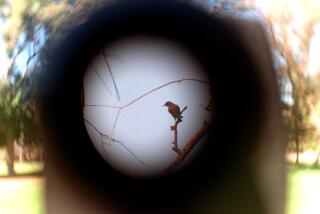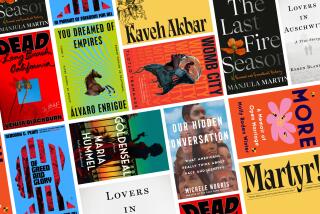‘The Unknown Knowns,’ Jeffrey Rotter; ‘American Salvage,’ Bonnie Jo Campbell; ‘Corvus: A Life With Birds,’ Esther Woolfson
The Unknown Knowns
A Novel
Jeffrey Rotter
Scribner: 272 pp., $25
For starters, the title is a riff on Donald Rumsfeld’s hilarious 2002 quote: “There are known knowns. There are things we know that we know. There are known unknowns. That is to say, there are things that we now know we don’t know. But there are also unknown unknowns. There are things we do not know we don’t know.”
Immediately, we know we are in Paranoiaville; take a left at Surreal and go down into Dada. And it feels good, yes, it does, to laugh at Agent Les Diaz, a low-level fed working in the Water Terror Emergency Readiness Team of Homeland Security, one of the novel’s two protagonists. Like Dwight in “The Office,” Diaz embraces bureaucracy. The other protagonist, Jim Rath, is 38 “in the worst way possible.” He can’t keep a job, he’s still obsessed with comics and he spends long hours in the pool of the Colorado Springs Hilton, where he has discovered evidence of a lost underwater civilization called Nautika.
Sure enough, Rath’s wife has left him. Diaz’s wife has recently passed away. Both men are grief-stricken, but that’s the least of their problems. Diaz feels certain that public pools are America’s soft underbelly. Rath feels they are a portal to Nautika. One man’s ancient civilization is another man’s terrorist breeding ground.
Paths cross; it is unclear which man is prey and which is predator. “I mean, what’s easier to explain to the American people, that some rogue domestic terrorist (i.e., me),” Rath thinks, “went nuts with spousal grief and perpetrated an isolated criminal act? Or that our collective disinterest in and ignorance about a lost aquatic civilization with an unapologetic feminist worldview has finally come back to bite us?”
You tell me. When you stop laughing.
American Salvage
Stories
Bonnie Jo Campbell
Wayne State University Press: 170 pp., $18.95 paper
OK, stop laughing. These stories are set in the meth world, which, more and more, seems to have its own landscape, economy and culture, even in literature. In these stories, this world is broken down into salvage and reinvented from the scraps: “Cocoa-buttered girls were stretched out on the public beach . . . if a weather satellite zoomed in on one of those bodies and then zoomed back out, the photos would show the curving beach itself was another woman, a fractal image made up of the particulate sunbathers. All the beaches pressed together might form female landmasses, female continents, female planets and galaxies. No wonder men felt tense.”
There’s a lot of collage-vision in these vertiginous stories -- waste on the edge of wilderness, belching up strange snakes, multitudes of bees, white ermines. Most of the stories contain crimes, and their chill lingers. These stories, some a few paragraphs, others longer, have bubbled up from our literary tributaries: small journals and literary reviews. Campbell’s is an original American voice -- two parts healthy fear, one part awe, one part irony, one part realism.
Corvus
A Life With Birds
Esther Woolfson
Counterpoint: 336 pp., $25
I like this book because it shows how life (even yours) can expand to include some new interest and how these new interests are like windows on a dark house. It all began, for Woolfson, with “the temptation to rescue.” Soon her home in Scotland was full of doves and a cockatiel and then, one day, a fledgling rook, Corvus frugilegus (meaning food gatherer), the family that includes crows, ravens and magpies. They named her Chicken.
Watching Chicken grow opened a universe onto bird behavior. Woolfson began to notice corvids in the wild and to read more about them. It doesn’t hurt that Woolfson, who grew up in Glasgow and has that straightforward, graceful Scottish facility with language, finds corvids beautiful: “The Japanese word ‘shibui’ most encapsulates for me what they are and how they look, a word defined as ‘austere, simple, quietly beautiful.’ (It is no surprise to me that they are portrayed at their most exquisite in the art of Hiroshige, Hokusai and others.”
As she watches Chicken, Woolfson meanders through Byron, the Great Fire of London, the Jacobite wars, the nature of intelligence, the evolution of wings and so much more. We get a sense of Chicken’s (and other birds that wander in and out of Woolfson’s orbit) personality. “The more I learn, the more I observe,” Woolfson writes, the “more mysterious, more miraculous” Chicken becomes.
More to Read
The biggest entertainment stories
Get our big stories about Hollywood, film, television, music, arts, culture and more right in your inbox as soon as they publish.
You may occasionally receive promotional content from the Los Angeles Times.










